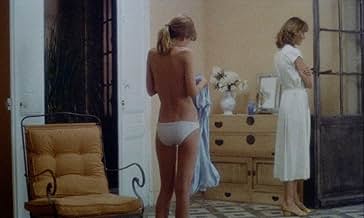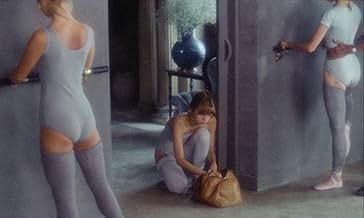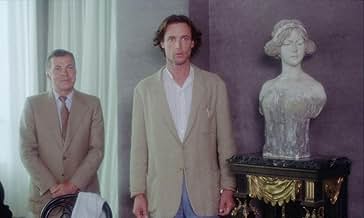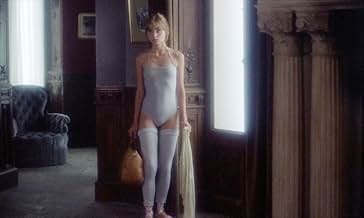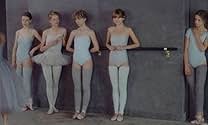CALIFICACIÓN DE IMDb
5.6/10
1.5 k
TU CALIFICACIÓN
El escultor Paul se reencuentra con un antiguo gran amor después de mucho tiempo, pero queda mucho más impresionado por su hija de 15 años, Laura, que se parece a su madre cuando Paul estaba... Leer todoEl escultor Paul se reencuentra con un antiguo gran amor después de mucho tiempo, pero queda mucho más impresionado por su hija de 15 años, Laura, que se parece a su madre cuando Paul estaba enamorado de ella.El escultor Paul se reencuentra con un antiguo gran amor después de mucho tiempo, pero queda mucho más impresionado por su hija de 15 años, Laura, que se parece a su madre cuando Paul estaba enamorado de ella.
- Dirección
- Guionistas
- Elenco
William Milié
- Le chorégraphe
- (as William Millie)
Gunilla Astrom
- Diane
- (sin créditos)
Bernard Daillencourt
- Docteur Benoît
- (sin créditos)
David Hamilton
- Un invité à la réception
- (sin créditos)
Katia Kofet
- Claudie
- (sin créditos)
Luciano
- Timothez Sega
- (sin créditos)
Michael Pochna
- Gérard
- (sin créditos)
Anja Schüte
- Dancer
- (sin créditos)
- Dirección
- Guionistas
- Todo el elenco y el equipo
- Producción, taquilla y más en IMDbPro
Opiniones destacadas
Laura, Les Ombres De L'ete
David Hamilton does a great job expressing his seeming obsession with pre-pubescent ballet dancers in Laura, Les Ombres De L'ete. Possibly one of the worst (and most boring) "art house" pictures ever made, professional photographer/amateur filmmaker Hamilton drowns in his excessive use of soft focus, pseudo-artistic fadeouts, and nudity, devices employed to make up for the shallow plot.
After seeing teenaged Laura (Dawn Dunlap) at ballet class, sculptor Paul Thomas Wyler (James Mitchell) knows that he must sculpt this beautiful little girl, just as he had done with her mother Sarah (Maud Adams) 20 or so years prior. But Sarah can see through his superficial intentions and tries her best to keep her very curious daughter from posing for this oh-so-artistic womanizer.
Laura contains several sequences of excessive nudity (mostly of young Dunlap) and there is no doubt that Hamilton's subjects are quite attractive; in fact, the photo-shoot scenes, with Sarah taking endless pictures of her naked daugher prancing around (including a few gymnastic poses), are certainly provocative. But like Hamilton's other exploitative French productions, the story is built around these sequences and without them there is little else to interest the viewer. The film comes across as heavy-handed, pretentious, and, ultimately, empty. Some termed this soft-core when it was released but the film simply isn't graphic enough to qualify for the category. -- David Ross Smith
David Hamilton does a great job expressing his seeming obsession with pre-pubescent ballet dancers in Laura, Les Ombres De L'ete. Possibly one of the worst (and most boring) "art house" pictures ever made, professional photographer/amateur filmmaker Hamilton drowns in his excessive use of soft focus, pseudo-artistic fadeouts, and nudity, devices employed to make up for the shallow plot.
After seeing teenaged Laura (Dawn Dunlap) at ballet class, sculptor Paul Thomas Wyler (James Mitchell) knows that he must sculpt this beautiful little girl, just as he had done with her mother Sarah (Maud Adams) 20 or so years prior. But Sarah can see through his superficial intentions and tries her best to keep her very curious daughter from posing for this oh-so-artistic womanizer.
Laura contains several sequences of excessive nudity (mostly of young Dunlap) and there is no doubt that Hamilton's subjects are quite attractive; in fact, the photo-shoot scenes, with Sarah taking endless pictures of her naked daugher prancing around (including a few gymnastic poses), are certainly provocative. But like Hamilton's other exploitative French productions, the story is built around these sequences and without them there is little else to interest the viewer. The film comes across as heavy-handed, pretentious, and, ultimately, empty. Some termed this soft-core when it was released but the film simply isn't graphic enough to qualify for the category. -- David Ross Smith
David Hamilton may have made his name as a photographer but Laura leaves his writing and directing abilities with a lot of question marks. The plot and characterisations have holes that you could drive an army through.
When Paul asks if Laura would pose for his new sculpture Sarah refuses so why does she then say that she will take photos of a naked Laura for Paul to use? It's as if she is saying, "No, Mr Wyler, Laura will not pose naked but I will take lots of photos of Laura in erotic poses so that you can ogle her young naked body at your leisure." This is surely not the action of a responsible parent, especially as she knows him well enough not to let Laura anywhere near him. This is evident at a party given by Paul. Sarah, her husband Richard and Laura are invited to the party but Laura is left at home. There are other unanswered questions such as what did the woman at the party want to talk to Paul about and why was Paul allowed access to the ballet school? There is more but it would take too long to go into it all here.
As this is an erotic film centred around art, there is obviously a certain amount of nudity. David Hamilton shows his photographic background by having the ballet students adopting various poses and so looking like living tableaux. There was too much use of fade-to-black and the permanent soft-focus was annoying. This film does not warrant more than 2 stars.
When Paul asks if Laura would pose for his new sculpture Sarah refuses so why does she then say that she will take photos of a naked Laura for Paul to use? It's as if she is saying, "No, Mr Wyler, Laura will not pose naked but I will take lots of photos of Laura in erotic poses so that you can ogle her young naked body at your leisure." This is surely not the action of a responsible parent, especially as she knows him well enough not to let Laura anywhere near him. This is evident at a party given by Paul. Sarah, her husband Richard and Laura are invited to the party but Laura is left at home. There are other unanswered questions such as what did the woman at the party want to talk to Paul about and why was Paul allowed access to the ballet school? There is more but it would take too long to go into it all here.
As this is an erotic film centred around art, there is obviously a certain amount of nudity. David Hamilton shows his photographic background by having the ballet students adopting various poses and so looking like living tableaux. There was too much use of fade-to-black and the permanent soft-focus was annoying. This film does not warrant more than 2 stars.
Artists are inspired by myths, and this picture-poem starts with an artist having a visionary view of the birth of Venus. To director David Hamilton this is a look at a woman before life leaves its many marks on her. Both Hamilton and the artist wants to freeze this moment of Adam-and-Eve-innocence, and both do it with sensual devotion. The innocence gets lost on the way, as we all know it will be - but in Hamiltons dream, as well as in his life as photographer, the sensuality not only remains, but grows stronger. Maud Adams shows as mother a strong believe in this, watching her daughter growing up. As the daughter, Laura, sees Dawn Dunlap.
Other comments shows too much interest for the amateurish acting in this picture-poem. As a mirror reflecting a world where we think too much and too little at the same time. We think too much with our senses turned off, and too little with our senses turned on. Brigitte Bardot was once asked by a journalist: "What do you think about free love?" Brigitte Bardot answered: "I don't think when I make love". If Hamilton was asked about his movie-theory for "Laura", he would probably answer: "I don't make movies, I'm just dreaming". The camera catch the dream and makes it possible to share it - and I'm very grateful that it has been possible for me to share Hamilton's dream.
David Hamilton is a child of a time - the 70's - where everybody was searching deep and wide, and he became famous in that time. Men like to see his pictures of girls, but back then it was the mothers who asked him to photograph their daughters. The style in Hamilton's picture-poems was not unusual for European movies in the 70's. A danish movie was inspired by Robert Frost: "The woods are lovely dark and deep / but I have promises to keep / and miles to go before I sleep." Perhaps the meaning in that poem is the reason why Hamilton wants to share his dreams.
Other comments shows too much interest for the amateurish acting in this picture-poem. As a mirror reflecting a world where we think too much and too little at the same time. We think too much with our senses turned off, and too little with our senses turned on. Brigitte Bardot was once asked by a journalist: "What do you think about free love?" Brigitte Bardot answered: "I don't think when I make love". If Hamilton was asked about his movie-theory for "Laura", he would probably answer: "I don't make movies, I'm just dreaming". The camera catch the dream and makes it possible to share it - and I'm very grateful that it has been possible for me to share Hamilton's dream.
David Hamilton is a child of a time - the 70's - where everybody was searching deep and wide, and he became famous in that time. Men like to see his pictures of girls, but back then it was the mothers who asked him to photograph their daughters. The style in Hamilton's picture-poems was not unusual for European movies in the 70's. A danish movie was inspired by Robert Frost: "The woods are lovely dark and deep / but I have promises to keep / and miles to go before I sleep." Perhaps the meaning in that poem is the reason why Hamilton wants to share his dreams.
David Hamilton is so impressed with himself as a photographer, that he has convinced himself he can make a good film. Well, he's wrong. For example, I have a theory that he saw a good use of a fade out in a movie once and thought that if one fade out is good, then 75 of them must be great! Again, he's wrong. There is one sequence where Sarah (Maud Adams) is speaking to her daughter Laura (Dawn Dunlap) who is lying in bed. The camera shows Sarah talking and then slowly fades out to black only to shift to Laura in bed as she responded directly to her mother and continues the conversation. Maybe Hamilton felt this would make the dialogue have more resonance. Again, he's wrong. I've noticed that Hamilton is wrong a lot in this film. The movie fails on so many levels that I cannot begin to list them all here. All I can say is that you should avoid this movie at all costs. I give it a 1/10.
David Hamilton established his name as a fashion photographer through the still, dreamy soft focus images of young girls, usually portrayed in muted colours, for which he has become famous. At some point he appears to have decided that this experience was all he needed to produce great movies, and he started to direct films that characteristically show all the same features as his fashion images. Unfortunately these were not generally well received and some critics have suggested that he has only a rudimentary appreciation of how to blend successive still images into an ongoing movie sequence. Personally I greatly enjoy his still fashion photography and this enjoyment is sufficient for me to also appreciate his films - overlooking any faults in their dynamics. His best known film is probably "Bilitis", a study of a young girl coming of age, but my preference is for "Laura", a film about a young girl modeling for a sculptor who is blinded in a fire. We can, I hope, ignore comments on the IMDb database which suggest that there is something sinister in Hamilton's preference for models and actresses who appear very young. In his films his objective is to create a story which has a strong emotional appeal but which is also visually beautiful to watch. My judgment is that Laura achieves this objective superbly. One sequence which haunts my memory as much as any other film sequence I have ever seen; comes towards the end of this film. It shows the sculptor, nearly blinded by the fire, returning to his almost finished sculpture whilst he explores the torso of his model with an extended finger trying to recreate in his mind the beauty that he can no longer see.
My recommendation would be to watch this film, which is not readily obtainable today, as soon as any opportunity arises.
POSTSCRIPT - added January 2005
This film has - to my surprise - now been released as a DVD. If these various very different assessments intrigue you in any way, why not buy a copy and add your comments to those already here?
My recommendation would be to watch this film, which is not readily obtainable today, as soon as any opportunity arises.
POSTSCRIPT - added January 2005
This film has - to my surprise - now been released as a DVD. If these various very different assessments intrigue you in any way, why not buy a copy and add your comments to those already here?
¿Sabías que…?
- TriviaWhen Laura is in the ballet shower, many of the poses duplicate paintings of Edgar Degas (an artist famed for his ballerina portraits).
- Versiones alternativasThe German cut is ten minutes shorter than the regular version at 85 mins.
Selecciones populares
Inicia sesión para calificar y agrega a la lista de videos para obtener recomendaciones personalizadas
- How long is Laura?Con tecnología de Alexa
Detalles
Contribuir a esta página
Sugiere una edición o agrega el contenido que falta


